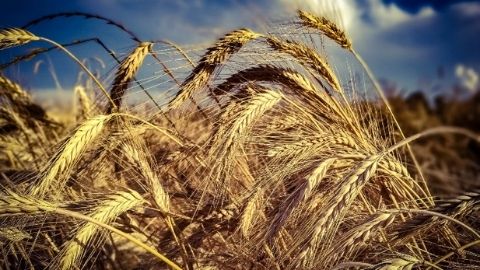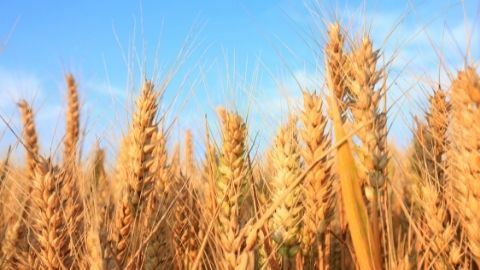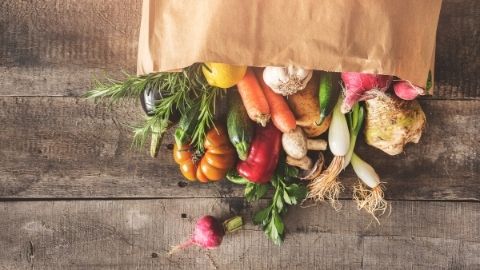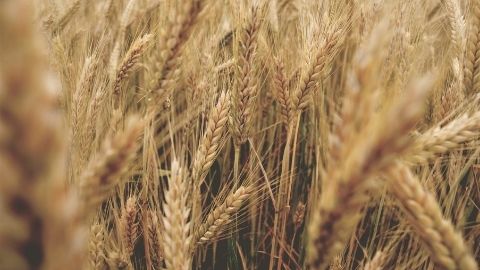Characteristics of Organic Wheat Growers
Introduction
Organic growers and their farms, in general, have certain characteristics in common, including age, gender, farm size, values, education level, etc. For example, organic fresh produce growers are generally younger, highly educated females (Kallas et al., 2010). Past research studies seeking to understand organic adoptors have focused mainly on organic produce growers and less on producers of typical commodities, such as grains and livestock. A recent study was conducted with wheat growers in the western U.S. which found notable differences in the grower and farm characteristics that influence organic adoption, including older age and the lack of importance of gender and farming experience (Quarnstrom, 2018). As the size and scope of commodity production is vastly different than that of fresh produce, it seems likely that the issues growers face in adopting organic wheat would also be different. Hence, the main goal of the study was to understand why more wheat growers do not adopt organic production methods, when the demand for organic wheat products exceeds supply, and thus, organic prices are much higher than conventional wheat prices (Koory, 2018). This fact sheet provides an overview of the study results and compares and contrasts these results with the results of other studies. It also provides suggestions for outreach to current and potential organic wheat growers.
Introduction
According to previous studies, organic growers tend to be younger, and typically less-experienced farmers (see Table 1). Also, growers with more information about organic production are more likely to engage in organic farming (Shams and Fard, 2017). This holds true for individuals with more formal education as well. Women are more likely than men to become organic growers, and households who are more financially secure overall are more likely to adopt organic methods (Padel, 2008).
Organic farms tend to be smaller in size than conventional farms. Also, if a farm is in close proximity to other organic farms, the grower is likely to adopt organic methods illustrating the impact of neighbor actions on decision making (Kallas et al., 2010). Growers that choose to implement organic farming practices are less risk-averse. Those uncomfortable with the volatility or organic pricing will be less likely to enter into organic production than those who are not risk-averse (Peterson et al., 2012).
 Organic Wheat Grower Characteristics
Organic Wheat Grower Characteristics
The study included an online survey of wheat growers in 14 western states contacted through state-based farming and grain growers' associations. The survey contained questions relating to grower socio-demographics, farm characteristics, history of production practices, trusted information sources, and concerns about organic production and implementing new technologies on the farm. Surveys were given to both conventional and organic wheat growers, resulting in 82 valid responses. The majority of the grower respondents were from Utah, Colorado, Montana, and Washington.
The study evaluated the impact of grower and farm characteristics on wheat grower adaption of organic growing practices. Many of the same characteristics examined in previous studies (see Table 1) were evaluated in this study as well. The results are provided in Table 2. We see that many of the characteristics examined in previous studies had no significant effect on grower adoption in this study. Also, several characteristics exhibited the same result, while others the opposite..
Table 1: Variable Effects on Organic Adoption – Past Studies
| Variable | +/- | Variable | +/- |
|---|---|---|---|
| Farm size | - | Risk averse | - |
| Family size | - | Perceived risk | - |
| Gender (female) | + | Environmental protection concerns | + |
| Education level | + | Organic policy incentives | + |
| Age | - | Personal belief in organic lifestyle | + |
| Years of farming experience | - | Concern for health | + |
| Knowledge of organic farming | + | Believes organic produces better quality product | + |
| Organic marketing concerns | - | Competition from other labels | - |
| Distance from processor | - | Concerns about organic yields | - |
| Concerns about financing | + | Concerns about weed and pest control | - |
| Transition costs | - | Volatility of organic premiums | - |
Source: Overview of previous studies.
Table 2: Variable Effects on Organic Wheat Adoption
| Variable | +/- | Variable | +/- |
|---|---|---|---|
| Farm size | - | Risk averse | - |
| Family size | NA | Perceived risk | None |
| Gender (female) | None | Concerns about financing | + |
| Education level | NA | Arid location | - |
| Age | + | Concerns about organic yields | None |
| Years of farming experience | None | Concerns about weed & pest control | None |
| Knowledge of organic farming | None | Volatility of organic premiums | None |
| Organic marketing concerns | None | ||
| Transition costs | None | ||
| Transition time | None | ||
Similarities to other organic adoptors
There are three primary characteristics that were consistent between organic growers in general and organic wheat growers: financing concerns, lower risk-aversion, and small farm size. Wheat production requires more expensive equipment and larger tracks of land than fresh produce production. As a result, having available financing is key to creating and maintaining a successful wheat farm, especially when planning to transition to organic methods. The second area is lower risk-aversion. Farmers who are risk averse likely fear the volatility of organic price premiums, while those who are not, are more likely to adopt organic practices because they view price premiums as an offset to the risk, rather than a contributor (Gardebroek, 2006). This still holds true for wheat farmers. The high cost associated with transitioning requires growers to take on a great deal of financial risk, thus providing a significant disincentive to risk-averse growers. Finally, as was found in previous studies, farms that are smaller in size are more likely to adopt organic practices (Kallas et al., 2010).
Differences to other organic adoptors
For organic wheat growers, gender was not a significant indicator of organic adoption, and while previous studies found that younger growers were more likely to go organic, the opposite was found to be true in the production of wheat. In fact, the largest age group in this study was age 60 and above. This result could be clouded if the primary older grower completed the survey, but their adult children have added organic wheat acreage on the farm. Another possible explanation is the high cost of wheat farming. Growers might not be able to afford the organic transition costs until they are financially stable, and that stability comes with time and age. While previous studies concluded that the availability of information regarding organic farming practices is key to the adoption of organic practices, this study found no correlation (Shams and Fard, 2017; Genius et al., 2006). Marketing was also found to be inconsequential. It is important to note, however, that marketing for wheat differs from that of fresh produce because it is not typically sold directly to the consumer. Rather, it is transformed into another product, like flour, and sold in that form. Finally, this study found that growers in arid areas (less than 10 inches of annual precipitation) were less likely to adopt organic practices. This effect may be due to the increased risk of crop loss due to drought in dryland production systems. However, weeds tend to be less prevalent in dry areas, which would increase yields and quality. Hence, this result does not make intuitive sense unless the wheat acreage is primarily irrigated.
Outreach Suggestions
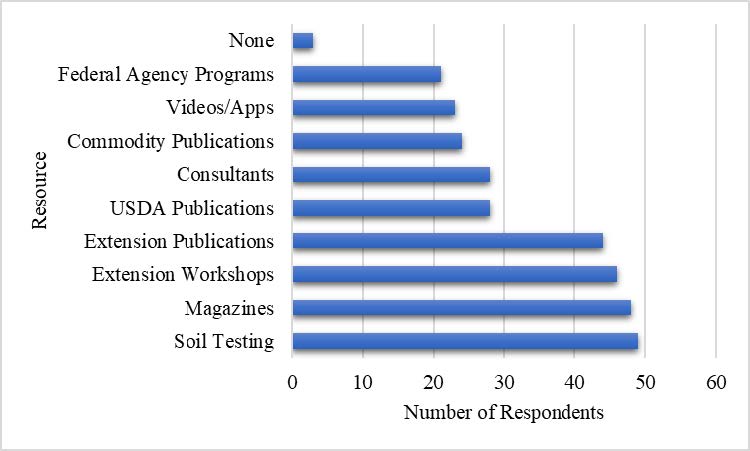
This study illustrates critical differences between organic wheat growers and other organic growers. Under-standing these differences will lead to improvements in and the ability to tailor outreach programming, educational opportunities, and grant and other programs, to best assist current and potential organic wheat growers.
While knowledge of organic farming practices or marketing was not statistically significant in increasing the potential for organic adoption, providing financial information and subsidies to offset the costs of transition could make a difference since the availability of financing was a significant factor in conversion. Although there are government programs that can assist, wheat farmers do not trust government information sources, nor do they heavily use federal programs (see Figure 1 and Table 3). Thus, other channels should be implemented to provide educational opportunities and financial assistance. For example, the respondent wheat farmers claim that their top two trusted sources of information are universities and neighbors (see Table 3). Since neighbors are so trusted, wheat growers could be organized into groups that allow them to connect with one another. The ability to discuss organic production issues with those who have already made the transition may provide needed answers and alleviate fears regarding the process.
Table 3: Ranking of Trusted Information Sources
| Rank of trust in information source (1 = most trusted) | Mode of responses |
|---|---|
| University | 1 |
| Neighbor | 1 |
| Extension resources | 3 |
| Product companies | 4 |
| Consultant | 5 |
| Commodity assication | 5 |
| Federal loans/programs | 7 |
Universities can contribute by holding Extension workshops and providing Extension publications on organic farming and transitioning to organic for wheat farmers, as well as help spread the word about financing opportunities. Both of those resources are used by growers frequently and were also ranked high as preferred information sources (see Table 4). Universities can also create organic farming certificate and degree programs and provide grants to assist growers. In addition to helping growers, this would provide the opportunity for students to get hands-on experience with organic farming methods. This would prepare students for their careers and increase the likelihood of the future generation continuing their involvement in farming, organic or otherwise. Also, conducting organic growing trials on grower-owned land would be especially helpful, as these trials on local farm land were ranked very highly as a preferred source of information by growers.
Table 4: Ranking of Preferred Information Providers
| Rank of preferred method for receiving information or tools (1 = most preferred) | Mode of responses |
|---|---|
| Coop. Extension publications/videos | 2 |
| Coop. Extension field days/workshops | 1 |
| Production/financial assessment tools | 7 |
| On-site consultant | 4 |
| Commodity association | 3 |
| Trial on personal land | 1 |
| Trial on other farms | 2 |
Conclusions
This fact sheet provides information about the characteristics of organic wheat growers, and how those characteristics differ from other organic growers. As the demand for organic wheat products grows, one cannot assume that organic wheat growers are the same as others in terms of their concerns and what outreach methods best suit them. Their main concerns include financing organic transition and input costs, but they do not trust the federal agencies to provide them with the financial support they require. The results of this study can help organizations, such as universities, support wheat producers by providing more relevant information through more trusted sources. Such resources will aid in organic transition and increase the number of organic products available on the market.
References
- Gardebroek, C. (2006). Comparing Risk Attitudes of Organic and Non-Organic Farmers with a Bayesian Random Coefficient Model. European Review of Agricultural Economics, 33(4), 485-510.
- Genius, M., Pantzios, C.J., and Tzouvelekas, V. (2006). Information Acquisition and Adoption of Organic Farming Practices. Journal of Agricultural and Resource Economics, 31(1), 93-113.
- Kallas, Z., Serra, T., and Gil, J.M. (2010). Farmers’ Objectives as Determinants of Organic Farming Adoption: The Case of Catalonian Vineyard Production. Agricultural Economics, 41(5), 409-423.
- Koory, R. (2018). Yields Hold Potential Boon for 2018 Organic Wheat Production. The Organic and Non-GMO Report. Retrieved from http://non-gmoreport.com/articles/yields-hold-potential-boon-for-2018-organic-wheat-production/.
- Padel, S. (2008). Values of Organic Producers Converting at Different Times: Results of a Focus Group Study in Five European Countries. International Journal of Agricultural Resources, Governance and Ecology, 7(1-2), 63-77.
- Peterson, H.H., Barkley, A., Chacón-Cascante, A., and Kastens, T.L (2012). The Motivation for Organic Grain Farming in the United States: Profits, Lifestyle, or the Environment? Journal of Agricultural and Applied Economics, 44(2), 137-155.
- Quarnstrom, D.L. (2018). Untangling the Economic and Social Impediments to Producer Adoption of Organic Wheat. Published master's thesis. Department of Economics, Utah State University.
- Shams, A., and Fard, Z.H.M. (2017). Factors Affecting Wheat Farmers' Attitudes toward Organic Farming. Polish Journal of Environmental Studies, 26(5), 2207-2214.
Date Published: May 2019
Authors
Kynda R. Curtis, Professor aand Extension Specialist, Department of Applied Economics; Emily Rice, Undergraduate Extension Intern, Department of Applied Economics; Donya L. Quarnstrom, Graduate Student, Department of Applied Economics
Related Research




